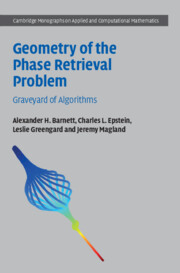Book contents
- Frontmatter
- Contents
- Preface
- Acknowledgments
- 1 Introduction
- Part I Theoretical Foundations
- Part II Analysis of Algorithms for Phase Retrieval
- Part III Further Properties of Hybrid Iterative Algorithms and Suggestions for Improvement
- 11 Introduction to Part III
- 12 Statistics of Algorithms
- 13 Suggestions for Improvements
- 14 Concluding Remarks
- 15 Notational Conventions
- References
- Index
13 - Suggestions for Improvements
from Part III - Further Properties of Hybrid Iterative Algorithms and Suggestions for Improvement
Published online by Cambridge University Press: 21 April 2022
- Frontmatter
- Contents
- Preface
- Acknowledgments
- 1 Introduction
- Part I Theoretical Foundations
- Part II Analysis of Algorithms for Phase Retrieval
- Part III Further Properties of Hybrid Iterative Algorithms and Suggestions for Improvement
- 11 Introduction to Part III
- 12 Statistics of Algorithms
- 13 Suggestions for Improvements
- 14 Concluding Remarks
- 15 Notational Conventions
- References
- Index
Summary
In this chapter, we consider several ideas that might lead to improved reconstructions in coherent diffraction imaging. To avoid the conditions that render the inverse problem ill conditioned, and the usual iterative algorithms nonconvergent, we consider approaches that entail (1) a modification of the sample preparation, (2) a new experimental modality, which uses a noniterative holographic Hilbert transform method to reconstruct the image, or (3) a geometric Newton-type algorithm. The final section describes the detailed implementation of the holographic Hilbert transform method. All of these proposals are illustrated with numerical experiments.
- Type
- Chapter
- Information
- Geometry of the Phase Retrieval ProblemGraveyard of Algorithms, pp. 249 - 291Publisher: Cambridge University PressPrint publication year: 2022

